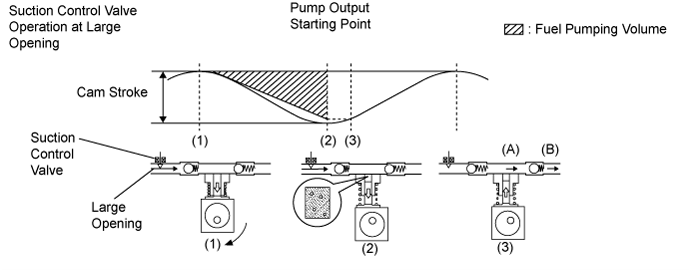Land Cruiser URJ200 URJ202 GRJ200 VDJ200 - 1VD-FTV ENGINE CONTROL
ECD SYSTEM (w/ DPF) - SYSTEM DESCRIPTION
| ENGINE CONTROL SYSTEM |

| *1 | ECM | *2 | Atmospheric Pressure Sensor (built into ECM) |
| *3 | Accelerator Pedal Position Sensor | *4 | Generator |
| *5 | Ignition Switch | *6 | Starter Signal |
| *7 | Vehicle Speed Signal | *8 | Battery Voltage |
| *9 | DLC3 | *10 | Other Signals |
| *11 | Stop Light Switch | *12 | No. 2 Glow Relay |
| *13 | No. 1 Glow Relay | *14 | EDU 2 Relay |
| *15 | No. 2 Injector Driver | *16 | EDU 1 Relay |
| *17 | No. 1 Injector Driver | - | - |

| *1 | Fuel Supply Pump Assembly | *2 | Suction Control Valve |
| *3 | Fuel Temperature Sensor | *4 | Common Rail Assembly (for Bank 1) |
| *5 | Fuel Pressure Sensor | *6 | Common Rail Assembly (for Bank 2) |
| *7 | Pressure Discharge Valve | *8 | Mass Air Flow Meter |
| *9 | Intake Air Temperature Sensor (Built Into Mass Air Flow Meter) | *10 | Intake Air Temperature Sensor (Turbo) |
| *11 | Diesel Throttle Body Assembly (for Bank 1) | *12 | Diesel Throttle Body Assembly (for Bank 2) |
| *13 | Manifold Absolute Pressure Sensor | *14 | No. 1 EGR Valve |
| *15 | No. 2 EGR Valve | *16 | EGR Cooler |
| *17 | Glow Plug | *18 | Injector Assembly |
| *19 | Camshaft Position Sensor | *20 | Crankshaft Position Sensor |
| *21 | Engine Coolant Temperature Sensor | *22 | DC motor, Nozzle Vane Position Sensor (for Bank 1) |
| *23 | DC motor, Nozzle Vane Position Sensor (for Bank 2) | *24 | Exhaust Gas Temperature Sensor (B1S1) |
| *25 | Exhaust Gas Temperature Sensor (B2S1) | *26 | No. 2 Exhaust Gas Temperature Sensor (B1S2) |
| *27 | No. 3 Exhaust Gas Temperature Sensor (B2S2) | *28 | No. 4 Exhaust Gas Temperature Sensor (B1S3) |
| *29 | No. 4 Exhaust Gas Temperature Sensor (B2S3) | *30 | Air Fuel Ratio Sensor (for Bank 1) |
| *31 | Air Fuel Ratio Sensor (for Bank 2) | *32 | Differential Pressure Sensor Assembly (for Bank 1) |
| *33 | Differential Pressure Sensor Assembly (for Bank 2) | *34 | Exhaust Fuel Addition Injector Assembly (for Bank 1) |
| *35 | Exhaust Fuel Addition Injector Assembly (for Bank 2) | *36 | Monolithic Converter Assembly RH (for Bank 1 CCo catalytic converter) |
| *37 | Monolithic Converter Assembly LH (for Bank 2 CCo catalytic converter) | *38 | Front Exhaust Pipe Assembly (for Bank 1 DPF catalytic converter) |
| *39 | Front No. 2 Exhaust Pipe Assembly (for Bank 2 DPF catalytic converter) | - | - |
| DIESEL PARTICULATE FILTER SYSTEM DESCRIPTION |
The diesel particulate filter System comprehensively regulates engine control (consists of a catalytic system and a fuel injection system) and purifies the particulate matter (PM) of diesel engines. The catalytic system purifies hydrocarbons (HC) and carbon monoxides (CO), and reduces PM with a catalytic converter using the Diesel Particulate Filter (DPF). The fuel injection system adds fuel into the exhaust port using the exhaust fuel addition injector to maintain a proper catalyst temperature for PM forced regeneration.
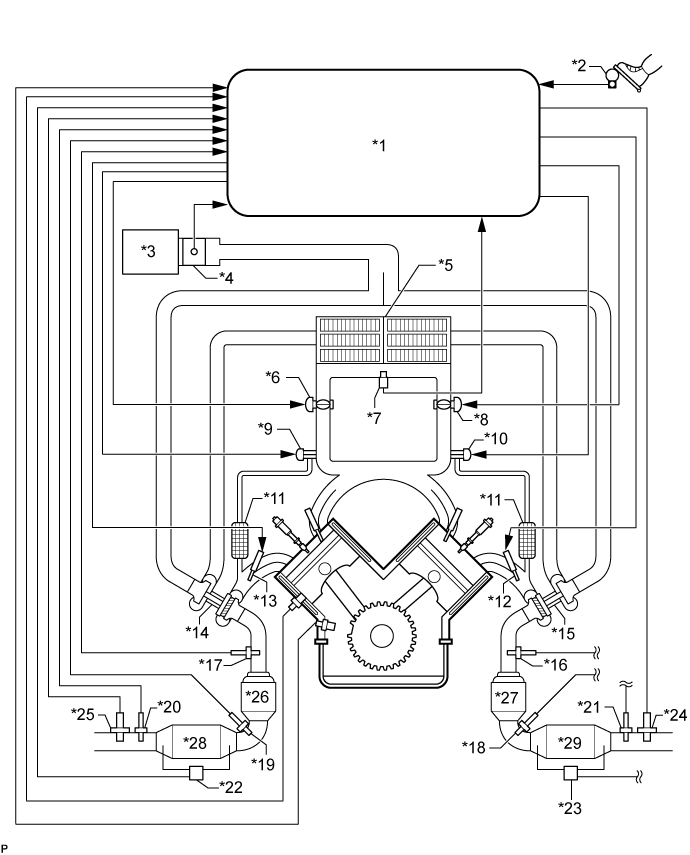
| *1 | ECM | *2 | Accelerator Pedal Sensor |
| *3 | Air cleaner | *4 | Mass Air Flow Meter |
| *5 | Intercooler | *6 | Diesel Throttle Body (for Bank 1) |
| *7 | Intake Air Temperature Sensor (Turbo) | *8 | Diesel Throttle Body (for Bank 2) |
| *9 | No. 1 EGR Valve | *10 | No. 2 EGR Valve |
| *11 | EGR Cooler | *12 | Exhaust Fuel Addition Injector Assembly (for Bank 2) |
| *13 | Exhaust Fuel Addition Injector Assembly (for Bank 1) | *14 | Turbocharger (for Bank 1) |
| *15 | Turbocharger (for Bank 2) | *16 | Exhaust Gas Temperature Sensor (B2S1) |
| *17 | Exhaust Gas Temperature Sensor (B1S1) | *18 | No. 3 Exhaust Gas Temperature Sensor (B2S2) |
| *19 | No. 2 Exhaust Gas Temperature Sensor (B1S2) | *20 | No. 4 Exhaust Gas Temperature Sensor (B2S3) |
| *21 | No. 4 Exhaust Gas Temperature Sensor (B1S3) | *22 | Differential Pressure Sensor (for Bank 1) |
| *23 | Differential Pressure Sensor (for Bank 2) | *24 | Air Fuel Ratio Sensor (for Bank 2) |
| *25 | Air Fuel Ratio Sensor (for Bank 1) | *26 | Monolithic Converter Assembly RH (for Bank 1 CCo catalytic converter) |
| *27 | Monolithic Converter Assembly LH (for Bank 2 CCo catalytic converter) | *28 | Front Exhaust Pipe Assembly (for Bank 1 DPF catalytic converter) |
| *29 | Front No. 2 Exhaust Pipe Assembly (for Bank 2 DPF catalytic converter) | - | - |
DPF components:
| Component | Description |
| Monolithic converter assembly (CCo catalytic converter) | Reduces HC and CO. |
| Front exhaust pipe assembly (DPF catalytic converter) | Reduces PM. |
| Exhaust Fuel Addition Injector Assembly | Adds fuel into the exhaust port in order to raise catalyst temperature for PM forced regeneration. |
| Exhaust gas temperature sensor | Used for estimating the DPF catalytic converter temperature and adjusting fuel addition by ECM while PM forced regeneration is performed. Also detects the DPF catalytic converter temperature to prevent the catalytic converter temperature from rising too high. |
| Differential Pressure Sensor Assembly | Detects the volume of PM deposits and any incorrect vacuum hose arrangement on the DPF catalytic converter. |
| Air fuel ratio sensor | Used for controlling the air-fuel ratio. By controlling the air-fuel ratio, combustion control and PM forced regeneration are properly regulated. |
Diagnostic Trouble Codes (DTCs) table for DPF:
- HINT:
- This table indicates typical DTC combinations for each malfunction occurrence.
| Trouble Area | Malfunction | DTC No. |
| Front exhaust pipe assembly (DPF catalytic converter) | Deteriorated or clogged | P062F, P200C*, P200D*, P200E*, P200F*, P2428*, P2429*, P244B*, P244C*, P244E*, P2458*, P2463*, P2465 |
| Exhaust Fuel Addition Injector Assembly | Stuck open | P20CF, P20D5 |
| Stuck closed | P244C, P244E, P2458* | |
| Low fuel addition volume | P244B*, P244C*, P244E*, P2458*, P2463 P2465, | |
| Open in exhaust fuel addition injector circuit | P20CD, P20D3, P244C, P244E, P2458* | |
| Short in exhaust fuel addition injector circuit | P20CF, P20D5, P20CD, P20D3, P244C, P244E*, P2458* | |
| Open or short in exhaust fuel addition injector circuit | P200C*, P200D*, P200E*, P200F*, P20CF*, P20D5*, P20CD, P20D3, P2428*, P244C*, P244E*, P2458* | |
| Exhaust gas temperature sensor | Open in exhaust gas temperature sensor circuit | P0545, P0546, P0548, P0549, P200C*, P200D*, P200E*, P200F*, P2428*, P2032, P2033, P2035, P2036, P2084, P2086, P242B, P242C, P242D, P2467, P2468, P244C*, P244E*, P2458*, P2469 |
| Short in exhaust gas temperature sensor circuit | P0545, P0546, P0548, P0549, P200C*, P200D*, P200E*, P200F*, P2428*, P2032, P2033, P2035, P2036, P2084, P2086, P242B, P242C, P242D, P2467, P2468, P244C*, P244E*, P2458*, P2469 | |
| Exhaust gas temperature sensor | P0545, P0546, P0548, P0549, P200C*, P200D*, P200E*, P200F*, P2428*, P2032, P2033, P2035, P2036, P2084, P2086, P242B, P242C, P242D, P2467, P2468, P244C*, P244E*, P2458*, P2469 | |
| Differential Pressure Sensor Assembly | Open in differential pressure sensor circuit | P244C* P2454, P2455, P2458*, P2460, P2461, P2463* |
| Short in differential pressure sensor circuit | P244C*, P244E*, P2454, P2455, P2458*, P2460, P2461, P2463* | |
| Differential pressure sensor | P244C*, P244E*, P2454, P2455, P2458*, P2460, P2461, P2463* | |
| Differential pressure sensor clogged | P244C*, P244E*, P2453, P2458*, P245F, P2463* | |
| Incorrect vacuum hose arrangement of the differential pressure sensor | P244C*, P244E*, P2453, P2458*, P245F, P2463* | |
| Air fuel ratio sensor | Open or short in air fuel ratio sensor or heater circuit | P0031, P0032, P0051, P0052, P2238, P2239, P2240, P2241, P2252, P2253, P2255, P2256, P244B*, P2463*, P2465 |
| Air fuel ratio sensor | P0031, P0032, P0051, P0052, P2195, P2197, P2238, P2239, P2240, P2241, P2252, P2253, P2255, P2256, P244B*, P2463*, P2465 | |
| Exhaust gas leaks | Exhaust gas leaks | P244C*, P2458* |
| Fuel leaks | Fuel leaks in fuel addition injector | P200C*, P200D*, P200E*, P200F*, P20CF*, P20D5*, P2428*, P244B*, P2458*, P244C*, P244E*, P2463*, P2465 |
| Fuel supply pump assembly | Correct fuel pressure cannot be fed to the exhaust fuel addition injector | P244B*, P244C*, P244E*, P2458*, P2463*, P2465 |
*: There may be no DTC output depending on the condition of the malfunction.
Diagnostic trouble code description for DPF:
| DTC No. | Description |
| P0031 | Open in air fuel ratio sensor heater (for bank 1) control circuit (Low output) |
| P0032 | Short in air fuel ratio sensor heater (for bank 1) circuit (High output) |
| P0051 | Open in air fuel ratio sensor heater (for bank 2) control circuit (Low output) |
| P0052 | Short in air fuel ratio sensor heater (for bank 2) circuit (High output) |
| P0545 | Open or short in exhaust gas temperature sensor circuit (B1S1) (Low output) |
| P0546 | Open or short in exhaust gas temperature sensor circuit (B1S1) (High output) |
| P0548 | Open or short in exhaust gas temperature sensor circuit (B2S1) (Low output) |
| P0549 | Open or short in exhaust gas temperature sensor circuit (B2S1) (High output) |
| P200C | DPF catalytic converter abnormally high exhaust gas temperature (bank 1 sensor 3) |
| P200D | DPF catalytic converter abnormally high exhaust gas temperature (bank 2 sensor 3) |
| P200E | DPF catalytic converter abnormally high exhaust gas temperature (bank 1 sensor 2) |
| P200F | DPF catalytic converter abnormally high exhaust gas temperature (bank 2 sensor 2) |
| P2032 | Open or short in exhaust gas temperature sensor circuit (B1S2) (Low output) |
| P2033 | Open or short in exhaust gas temperature sensor circuit (B1S2) (High output) |
| P2035 | Open or short in exhaust gas temperature sensor circuit (B2S2) (Low output) |
| P2036 | Open or short in exhaust gas temperature sensor circuit (B2S2) (High output) |
| P2084 | Exhaust Gas Temperature Sensor Circuit Range/Performance (B1S2) |
| P2086 | Exhaust Gas Temperature Sensor Circuit Range/Performance (B2S2) |
| P20CD | Open in exhaust fuel addition injector (for bank 1) circuit |
| P20CF | Exhaust fuel addition injector assembly (for bank 1) stuck open |
| P20D3 | Open in exhaust fuel addition injector (for bank 2) circuit |
| P20D5 | Exhaust fuel addition injector assembly (for bank 2) stuck open |
| P2195 | Air fuel ratio sensor (for bank 1) stuck lean |
| P2197 | Air fuel ratio sensor (for bank 2) stuck lean |
| P2238 | Open or short in air fuel ratio sensor (for bank 1) circuit (Low output) |
| P2239 | Open or short in air fuel ratio sensor (for bank 1) circuit (High output) |
| P2241 | Open or short in air fuel ratio sensor (for bank 2) circuit (Low output) |
| P2242 | Open or short in air fuel ratio sensor (for bank 2) circuit (High output) |
| P2252 | Open or short in air fuel ratio sensor (for bank 1) circuit (Low output) |
| P2253 | Open or short in air fuel ratio sensor (for bank 1) circuit (High output) |
| P2255 | Open or short in air fuel ratio sensor (for bank 2) circuit (Low output) |
| P2256 | Open or short in air fuel ratio sensor (for bank 2) circuit (High output) |
| P2428 | DPF catalytic converter abnormally high exhaust gas temperature (bank 1 sensor 1) |
| P2429 | DPF catalytic converter abnormally high exhaust gas temperature (bank 2 sensor 1) |
| P242B | Exhaust Gas Temperature Sensor Circuit Range / Performance (B1S3) |
| P242C | Open or short in exhaust gas temperature sensor circuit (B1S3) (Low output) |
| P242D | Open or short in exhaust gas temperature sensor circuit (B1S3) (High output) |
| P2467 | Exhaust Gas Temperature Sensor Circuit Range/Performance (B2S3) |
| P2468 | Open or short in exhaust gas temperature sensor circuit (B2S3) (Low output) |
| P2469 | Open or short in exhaust gas temperature sensor circuit (B2S3) (High output) |
| P244B | DPF catalytic converter (for bank 1) excessive differential pressure (High input) |
| P244C | DPF catalytic converter (for bank 1) insufficient temperature increase |
| P244E | DPF catalytic converter (for bank 2) insufficient temperature increase |
| P2453 | Differential pressure sensor (for bank 1) is clogged or has incorrect vacuum hose arrangement |
| P2454 | Open or short in differential pressure sensor (for bank 1) circuit (Low output) |
| P2455 | Open or short in differential pressure sensor (for bank 1) circuit (High output) |
| P2458 | Diesel Particulate Filter Regeneration Duration |
| P245F | Differential pressure sensor (for bank 2) is clogged or has incorrect vacuum hose arrangement |
| P2460 | Open or short in differential pressure sensor (for bank 2) circuit (Low output) |
| P2461 | Open or short in differential pressure sensor (for bank 2) circuit (High output) |
| P2463 | DPF catalytic converter soot deposition |
| P2465 | DPF catalytic converter (for bank 2) excessive differential pressure (High input) |
| COMMON RAIL SYSTEM DESCRIPTION |
Common rail system:
The common rail system uses high-pressure fuel for improved fuel economy. This system also provides robust engine power while suppressing engine vibration and noise.
This system stores fuel in the common rail assembly, which has been pressurized and supplied by the fuel supply pump assembly. By storing fuel at high-pressure, the common rail system can provide fuel at stable fuel injection pressures, regardless of engine speed or engine load.
The ECM, using the injector driver, provides an electric current to the piezo actuator in each injector to regulate the fuel injection timing and volume. The ECM also monitors the internal fuel pressure of the common rail assembly using the fuel pressure sensor. The ECM causes the fuel supply pump assembly to supply the fuel necessary to obtain the target fuel pressure.
In addition, this system uses a piezo actuator inside each injector to open and close the fuel passages. Therefore, both fuel injection time and fuel injection volume can be precisely regulated by the ECM.
The common rail system allows a multi-stage fuel injection process. In order to soften combustion shock, this system performs "pilot-injection" prior to the main fuel injection. This helps to reduce engine vibration and noise.
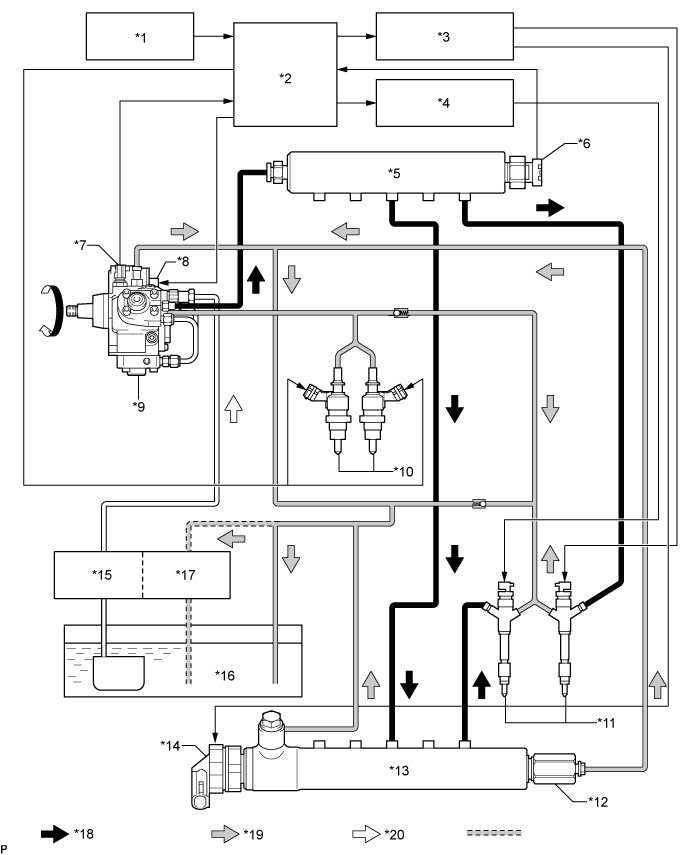
| *1 | Sensors | *2 | ECM |
| *3 | No. 1 Injector Driver | *4 | No. 2 Injector Driver |
| *5 | Common Rail (for Bank 1) | *6 | Fuel Pressure Sensor |
| *7 | Fuel Temperature Sensor | *8 | Suction Control Valve |
| *9 | Fuel Supply Pump | *10 | Exhaust Fuel Addition Injector |
| *11 | Injector Assembly | *12 | Pressure Limiter |
| *13 | Common Rail (for Bank 2) | *14 | Pressure Discharge Valve |
| *15 | Fuel Filter | *16 | Fuel Tank |
| *17 | Fuel Heater | *18 | High Pressure Fuel |
| *19 | Return Fuel | *20 | Suction Fuel |
- HINT:
- If there is a problem with a fuel return pipe, as bleeding air from the fuel system may not be able to be performed properly in certain instances, such as after replacing an injector assembly, etc., the engine startability may deteriorate.
Common rail system components:
| Component | Description |
| Common rail assembly | Stores high-pressure fuel produced by fuel supply pump assembly |
| Fuel supply pump assembly | Operated by crankshaft via gear Supplies high-pressure fuel to common rail assembly |
| Injector assembly | Injects fuel to combustion chamber based on signals from ECM |
| Fuel pressure sensor | Monitors internal fuel pressure of common rail and sends signals to ECM |
| Pressure discharge valve | Based on signals from ECM, opens valve when sudden deceleration occurs, or when engine switch is off to prevent fuel pressure from becoming too high. |
| Suction control valve | Based on signals from ECM, adjusts fuel volume supplied to common rail and regulates internal fuel pressure |
| Check valve | Keeps pressure that discharges from injector |
Diagnostic trouble code (DTC) table for the common rail system:
- HINT:
- This table indicates typical DTC combinations for each malfunction occurrence.
| Trouble Area | Malfunction | DTC No. |
| Injector assembly | Open or short in injector circuit | P0093*, P0201, P0202, P0203, P0204, P0205, P0206, P0207, P0208, P062D, P062E |
| Stuck open | P0093 | |
| Stuck closed | P0301, P0302, P0303, P0304, P0305, P0306, P0307, P0308 | |
| Fuel pressure sensor | Open or short in fuel pressure sensor circuit or pressure sensor output fixed | P0087, P0190, P0192, P0193 |
| Pressure discharge valve | Open or short in pressure discharge valve circuit | P0088*, P0093*, P1229*, P1271, P1272 |
| Stuck open | P0093 | |
| Stuck closed | P0088*, P1272 | |
| Suction control valve | Open or short in suction control valve circuit | P0627, P1229, P0088* |
| Stuck open | P0088*, P1229 | |
| Injector driver | Faulty injector driver | P0093*, P0201*, P0202*, P0203*, P0204*, P0205*, P0206*, P0207*, P0208*, P062D*, P062E*, P1271*, P1272* |
| Common rail system (Fuel system) | Fuel leaks in high-pressure area | P0093 |
*: There may be no DTC output depending on the condition of the malfunction.
Diagnostic trouble code description for the common rail system:
| DTC No. | Description |
| P0087 | Fuel pressure sensor output does not change |
| P0088 | Internal fuel pressure too high (250000 kPa [2550 kgf/cm2, 36250 psi] or more) |
| P0093 | Fuel leaks in high-pressure areas |
| P0190 | Open or short in fuel pressure sensor circuit (output voltage is too low or too high) |
| P0192 | Open or short in fuel pressure sensor circuit (output voltage is too low) |
| P0193 | Open or short in fuel pressure sensor circuit (output voltage is too high) |
| P0201 to P0208 | Open or short in No. 1 to No. 8 injector circuit |
| P0301 to P0308 | Cylinder 1 to 8 misfire detected |
| P0627 | Open or short in suction control valve circuit |
| P062D | Open or short in No. 1 injector driver |
| P062E | Open or short in No. 2 injector driver |
| P1229 | Fuel over-feed |
| P1271 | Open or short in pressure discharge valve circuit |
| P1272 | Pressure discharge valve stuck close |
| FUEL SUPPLY PUMP OPERATION SYSTEM DESCRIPTION |
Due to the rotation of the inner cam (eccentric cam), the outer cam pushes plunger A upward as illustrated below. The force of the spring pulls plunger B and C. As a result, plunger B and C draw fuel in, and plunger A pumps fuel at the same time.
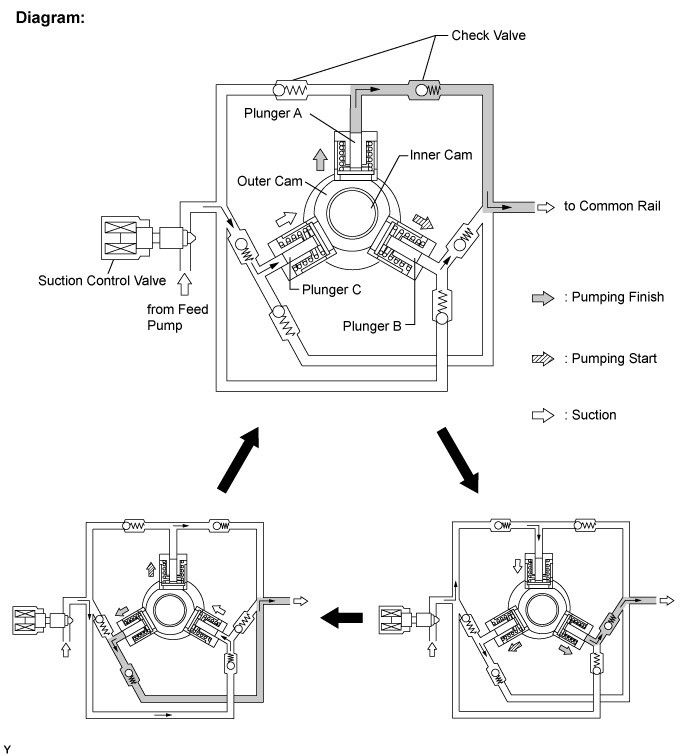
| SUCTION CONTROL VALVE OPERATION SYSTEM DESCRIPTION |
- HINT:
- The ECM controls the suction control valve operation to regulate the fuel volume that is produced by the fuel supply pump assembly for the common rail. This control is performed to regulate the internal fuel pressure of the common rail to the target injection pressure.
Small opening of the suction control valve:
When the opening of the suction control valve is small, the volume of supplied fuel is small.
The suction volume becomes small due to the narrow path despite the plunger stroke being full. The difference between the geometrical volume and suction volume creates a vacuum.
Pump output will start when the fuel pressure at (A) becomes higher than the common rail pressure (B).
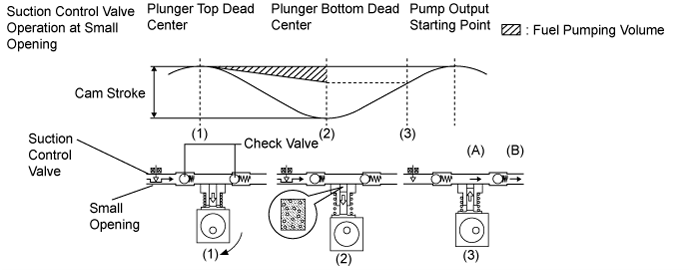
Large opening of the suction control valve:
When the opening of the suction control valve is large, the volume of supplied fuel is large.
If the plunger stroke is full, the suction volume becomes large because of the wide path.
Pump output will start when the fuel pressure at (A) becomes higher than the common rail pressure (B).
